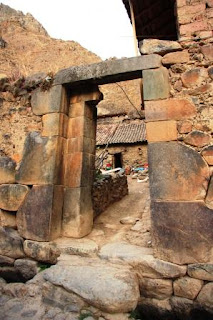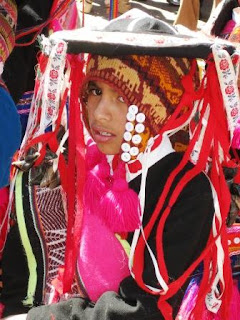
Jon and the ladies - those of us who weren´t at Machu Picchu.



Our favourite street in Cusco - the one with Jacks (not Hungry Jacks by the way).






One of the many children wandering around.

Beth, a nurse from Adelaide, looking after a sick child. The girl had to walk 1.5 hours home across country despite having a temperature of 39 degrees.
 A view of the valley below from on top of the mountain. This is where the bus toppled over the cliff and the driver died (not our bus thankfully).
A view of the valley below from on top of the mountain. This is where the bus toppled over the cliff and the driver died (not our bus thankfully). 
A photo snuck surrepticiously so I didn´t have to pay.


The entrance to the sun dial.
A view of the temples.

Even more Inca terraces - they are everywhere. They must have been very fit.

On Tuesday after a leisurely start to the day we set off to the Inca fortress perched dramatically on the mountain above Pisac. This meant driving up a very windy, steep road to the archeological site above. In many sectors, the ruins are built right along the edge of an abyss. Elizabeth and Sophie were both not feeling too well so they stayed with the bus whilst the rest of us elected to start the walk along the terraces that would eventually lead us back down the mountain to Pisac village. Whilst they were in the car park another bus tried to squeeze between the side of the cliff and a row of parked cars. Thankfully, the driver had already dropped off his passengers, as he hit another bus and plunged down the side of the cliff, flying out the window. This stupid decision cost the 26 year old driver his life. He was dead by the time some tourists, who were doctors, reached the wreckage. Elizabeth and Sophie witnessed the whole spectacle and were understandably rather shaken up. The rest of our group heard the ambulance sirens as we were exploring the ruins but had no idea what they were for until later.
The sites we were visiting kept getting better and better. I can’t wait to go to Machu Picchu. The path we took lead us past an Incan cemetery ~ holes in the mountain where mummies were placed. Apparently a mummy can fetch a decent price on the black market so guards have to continually watch over this area to keep the grave robbers at bay. We marched past more terraces and storage rooms along the mountain and through a short tunnel carved into the rock, to the ceremonial area which consists of a sun dial, altars, water fountains and basins, and a ceremonial platform. The water features were very impressive and would have made Jamie Durie proud. Inspired by the amazing plumbing, Jon now wants to install some Incan aqueducts in our backyard!
We then headed down the mountain past many circular ruins that would have been guard posts and watch towers. The hundreds of steep steps (apparently nothing compared to the Machu Picchu Inca Trail) led us all the way back to the Pisac market where I quickly forgot about my sore legs and went shopping! Turns out the alpaca blanket I bought as a gift for someone is only about 20% alpaca and I could have got it for half the price at another stall. I hate it when that happens!
On the way back to the volunteer house we passed another accident. This time a local bus had met head on with a pregnant cow. Didn’t seem like anyone was hurt but the cow was not so fortunate. It was lying dead in the middle of the road and had made a mess of the windscreen.



The second site - Ollantaytambo







The Sacred Valley, just outside Cusco, is named so because of the fertility of its soils and the richness of the flora and fauna. The area stretches for about 100 kilometres from Pisac to Machupicchu and includes several towns and the majority of the monuments that were built during the Empire of the Incas. Winding its way along the valley, between snow capped peaks as high as 5000 metres, is the Vicanota River (Sacred River). All of these things combine to form an area of breathtaking beauty which we explored for two days.
We set off in two buses for Chinchero first. Unfortunately, not all the group came as Ross and Fiona had collected some amoebas somewhere along the way and needed bed rest. Our group seems to be taking turns contracting sallmonelosis, diarrhea, giardiasis and other nasty ailments. So far Jon and I have remained immune although there is something to be said about altitude and gas (it is not just us).
Chinchero is known as the “birthplace of the rainbow”, although I don’t know why, it wasn’t as though it was more colourful than other places we have seen. Maybe it has something to do with the vibrant market that takes place here on Sundays. We had to climb a rather steep cobblestone street up to the colonial church and Inca ruins. The church, although rather dark and damp, was elaborately decorated inside (every square inch of the ceiling was covered in paintings) with a combination of Christian and local indigenous beliefs (such as sacred mountains painted behind angels). Parts of the walls were made from sections of the Inca temple that once stood on the site. The Inca ruins mostly consisted of impressive terraces and fragments of terracotta pottery. There were also ceremonial alters and a throne facing the sacred mountains which made for a rather scenic vista.
After lunch we headed over to the town of Ollantaytambo, the best surviving example of Inca city planning. The narrow cobblestone streets have been continuously inhabited for over 700 years. Built on approximately 600 hectares, it contains religious, astronomical, administrative and urban complexes, with areas reserved for activities related to agriculture and livestock.
We had to climb hundreds of steps (thank goodness for our 1000 step training in Belgrave ~ not that it has really helped at all) up the steep terraced mountain to reach the ceremonial areas that overlook the town below. The Incas must have been a very fit race. On the day of the winter solstice (June 21st) the sun’s rays peak over Pinkuylluna, a nearby mountain, that has been carved into a face known as Wiracochan or Tunupa (if you use your imagination). The rays actually shine through the eye, and light up the Temple of the Sun. I wonder how long it took them to get that right! The Incas seem to like doing that sort of thing as a means of astronomical observations and keeping time. Nearby the carved face are the ruins of storage rooms, built high up the mountain to keep the produce cool and insects at bay.
Apparently Ollantaytambo marks one of the few places where the conquistadors lost a major battle, when Manco Inca threw missiles (giant stones) onto the plain below. You can see the stones lying there still. I found this place, which is surrounded by snow capped mountains, amazing. I really liked Chinchero but this place was even more spectacular, possibly because there was more then just terraces to see. There was also a quaint town at the bottom which I would have liked more time to wander through.
That evening we slept at the town of Pisac, which marks the start of the Sacred Valley (we seem to be doing this tour backwards). It was fantastic to have a long, hot shower with strong water pressure (something we don’t seem to have at the volunteer house ~ possibly a good thing as it means no one spends too much time in the bathroom, especially Jon who has been known to fall asleep under the shower back home).











